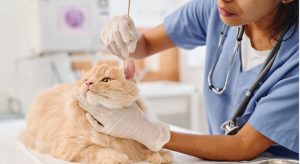Are you a proud cat parent who wants to keep your feline friend’s ears clean and healthy? Well, you’ve come to the right place! Ear cleaning is an essential part of your cat’s grooming routine, but it can sometimes be a tricky task.
Don’t worry, though, because, in this blog post, we’ll guide you through the process of how to clean cats ears like a pro. From understanding why ear cleaning is important to providing step-by-step instructions, we’ve got you covered. So grab your supplies and get ready for some purr-fectly clean cat ears! Let’s dive in!
Why is Ear Cleaning Important for Cats?

Why is ear cleaning important for cats? Well, let’s start by understanding that cats are meticulous groomers. They spend a significant amount of time licking themselves clean, but their ears often get neglected in this process. Regularly cleaning your cat’s ears helps to prevent the buildup of dirt, wax, and debris that can lead to infections.
Cats with long hair or excessive earwax production may be more prone to ear issues. Additionally, outdoor cats or those who frequently come into contact with other animals may be at a higher risk of picking up parasites like ear mites. By regularly inspecting and cleaning your cat’s ears, you can catch any potential problems early on and provide timely treatment.
Ear cleanliness is particularly crucial for breeds with folded or floppy ears as they have a higher chance of moisture accumulation within the ear canal, leading to bacterial overgrowth. Furthermore, regular ear cleaning sessions create an opportunity for you to monitor any changes in odour or discharge from the ears, which could indicate an underlying health issue.
By incorporating routine ear cleaning into your cat’s grooming regimen, you’re helping maintain their overall well-being and keeping them comfortable in the long run. So don’t forget about those furry little ears—they deserve some TLC, too!
How Often Should You Clean Your Cat’s Ears?
Cats are known for their cleanliness, but that doesn’t mean they don’t need a little help in certain areas. One such area is their ears. So, how often should you clean your cat’s ears?
The frequency of ear cleaning will vary depending on the individual cat and its specific needs. Generally, it is recommended to clean your cat’s ears once every 1-2 weeks as part of their regular grooming routine.
However, there are some factors that may require more frequent cleaning. For example, cats with long hair or those who spend a lot of time outdoors may need more frequent ear cleanings to prevent dirt and debris from building up.
On the other hand, if your cat has no noticeable problems with its ears and is not prone to wax buildup or infections, you may be able to reduce the frequency of cleanings to once a month.
Supplies You’ll Need to Clean Your Cat’s Ears

When it comes to cleaning your cat’s ears, having the right supplies on hand is essential. Here are a few items you’ll need before you get started:
- Ear cleaning solution: Look for a gentle, vet-approved ear cleaning solution specifically formulated for cats. Avoid using any homemade solutions or products not intended for feline use.
- Cotton balls or pads: These will be used to apply the ear-cleaning solution and gently wipe away any debris from your cat’s ears.
- Q-tips (optional): While not always necessary, Q-tips can be helpful in reaching small crevices in your cat’s ears if recommended by your veterinarian.
- Towels or wipes: Have some towels or wipes handy to clean up any messes that may occur during the process.
- Treats: Rewarding your cat with treats after each successful ear cleaning session can help make it a positive experience for them.
Remember, always check with your veterinarian before starting an ear cleaning routine and follow their recommendations regarding supplies and techniques tailored to your specific furry friend.
Preparing Your Cat for Ear Cleaning
Before you begin cleaning your cat’s ears, it’s crucial to prepare them mentally and physically. Cats are known for their independent nature, so it’s essential to approach ear cleaning calmly and patiently.
Find a quiet and comfortable space where you can perform the ear cleaning without distractions. It could be a small room or even your bathroom. Make sure the area is warm enough, as cats tend to feel more relaxed in cosy environments.
Next, gather all the necessary supplies before bringing your cat into the designated space. This includes cotton balls or pads specifically made for pet care, an appropriate ear-cleaning solution recommended by your veterinarian, and treats that your cat loves.
Now comes the important part: getting your cat used to having their ears touched. Begin by gently stroking their head and gradually move towards their ears. Observe how they respond – if they seem uncomfortable or anxious, take a break and try again later.
Introduce positive reinforcement techniques during these touch sessions by offering treats or verbal praise whenever they show tolerance towards ear handling. This will help create positive associations with the entire process of ear cleaning.
Remember to never rush this step; let your cat set the pace. If they become too stressed or resistant despite repeated attempts at desensitisation training, consult with a professional trainer or behaviourist who specialises in feline behaviour.
Step-by-Step Guide On How to Clean Cats Ears

Cleaning your cat’s ears may seem like a daunting task, but with the right approach and some patience, it can be done effectively. Here is a step-by-step guide to help you through the process.
First, gather all the necessary supplies before starting. You will need cotton balls or pads, an ear-cleaning solution specifically made for cats (avoid using alcohol-based solutions), and possibly some treats as rewards for your furry friend.
Next, find a quiet and comfortable space where you can work on cleaning your cat’s ears without distractions. It could be a bathroom or any other room where you can easily access running water if needed.
Gently hold your cat and speak to them in soothing tones to keep them calm throughout the process. Start by inspecting their ears for any signs of redness, discharge, or odour. If you notice anything unusual or suspect an infection, it’s best to consult with your veterinarian before attempting to clean their ears yourself.
To begin cleaning, take one of the cotton balls or pads and soak it in the ear-cleaning solution. Gently lift one of your cat’s ears and hold it between your fingers while carefully wiping away any visible dirt or debris from the outer part of their ear canal.
If there are stubborn dirt particles that won’t come off easily with just wiping, do not force them out forcefully! Instead, use the more ear-cleaning solution on another cotton ball/pad and repeat gentle swipes until everything appears clean.
Repeat these steps for both ears if necessary, but always remember that every cat is different; some may require frequent cleanings while others may rarely need them at all—always follow individual needs based on guidance from your vet!
| Step | Instruction |
| 1 | Gather all necessary supplies: cotton balls or pads, cat-specific ear-cleaning solution, treats for rewards. |
| 2 | Find a quiet, comfortable space with access to running water. |
| 3 | Hold your cat gently and speak soothingly to keep them calm. Inspect ears for redness, discharge, or odor. Consult vet if needed. |
| 4 | Soak a cotton ball in ear-cleaning solution. Lift cat’s ear, wipe away visible dirt gently from outer ear canal. |
| 5 | Use more solution on a new cotton ball for stubborn dirt. Avoid forcing debris out forcefully; repeat gentle swipes until clean. |
Common Questions and Concerns about Cleaning Cat’s Ears

Is it safe to clean my cat’s ears at home?
Cleaning your cat’s ears at home can be safe as long as you follow proper techniques and use the right supplies. However, if you’re unsure or uncomfortable doing it yourself, it’s always best to consult a veterinarian.
How do I know if my cat has an ear infection?
Some signs of an ear infection in cats include scratching or rubbing their ears excessively, redness or swelling in the ear canal, a foul odour coming from the ears, and discharge or wax buildup. If you suspect an infection, seek veterinary advice for proper diagnosis and treatment.
Can I use cotton swabs to clean my cat’s ears?
It is not recommended to use cotton swabs (Q-tips) when cleaning your cat’s ears. They can push debris further into the ear canal or even damage delicate structures inside the ear. Instead, opt for specially designed pet ear wipes or ask your vet for guidance on suitable cleaning products.
My cat hates having its ears cleaned! What should I do?
Some cats may resist having their ears cleaned initially, but with patience and positive reinforcement training, they can become more cooperative over time. Start by getting them used to gentle handling around their head and gradually introduce them to the process using treats as rewards.
Should I clean my indoor-only cat’s ears too?
Yes, even indoor cats are susceptible to dirt and wax buildup in their ears that could potentially lead to infections if left unaddressed. Regularly inspecting and cleaning your indoor-only cat’s ears helps maintain good hygiene and prevents potential issues down the line.
Remember: If you have any concerns about cleaning your cat’s ears or notice any unusual symptoms during the process, such as bleeding or extreme discomfort exhibited by your feline friend — don’t hesitate to reach out to a veterinarian for professional advice. They can provide proper guidance and ensure your cat’s ears stay clean.
When to Contact a Veterinarian for Ear Issues?

Ear issues can be common in cats, and while some cases of ear problems can be easily treated at home, there are certain situations where it’s crucial to seek veterinary assistance. If you notice any of the following signs or symptoms, it’s time to contact your veterinarian:
- Persistent scratching or pawing at the ears: While occasional scratching is normal for cats, excessive and persistent scratching can indicate an underlying issue, such as ear mites or an infection.
- Foul odour from the ears: A strong and unpleasant smell coming from your cat’s ears could be a sign of infection or other problems that require medical attention.
- Discharge from the ears: Any abnormal discharge that is yellowish, brownish, bloody, or pus-like should not be ignored. It may indicate an infection or injury that needs professional treatment.
- Redness, swelling, or inflammation: If you notice redness and swelling around your cat’s ears accompanied by discomfort or pain when touched, it could be a sign of an allergic reaction or infection.
- Changes in behaviour: Keep an eye out for changes in your cat’s behaviour, such as head shaking, tilting their head to one side consistently, loss of balance, and disorientation – these might point towards more serious conditions like middle-ear infections.
- Ear hematoma: If you notice a swollen area on the outer part of your cat’s ear that feels warm to the touch and seems painful – this may have developed due to trauma caused by vigorous scratching; immediate veterinary care is necessary here too.
Remember that every cat is unique and may exhibit different symptoms when dealing with ear issues. It’s important not to delay seeking veterinary advice if something seems off with your feline friend’s ears! Your vet will provide a proper diagnosis and recommend appropriate treatments based on their expertise.
Conclusion
A clean set of ears is crucial to your cat’s general health and wellbeing. Cleaning your ears on a regular basis helps avoid infections, pain, and possible hearing loss.
By following the steps outlined in this How to Clean Cats Ears guide and using the right supplies, you can make the process easy and stress-free for both you and your furry friend.
Remember to approach ear cleaning calmly, be patient with your cat, and always consult with a veterinarian if you have any concerns or notice any unusual symptoms.
With proper care and attention, your cat’s ears will stay clean and healthy, allowing them to lead a happy and comfortable life. So don’t forget to add ear cleaning into your cat’s grooming routine and give those cute little ears the TLC they deserve!







